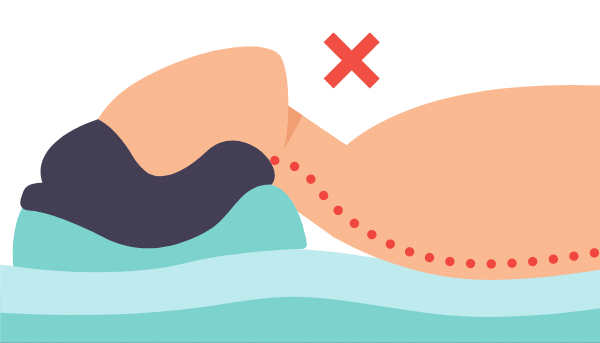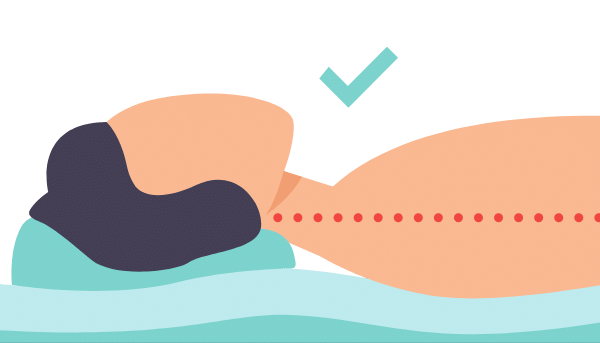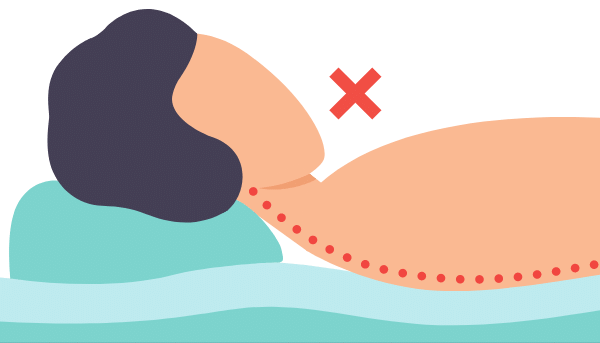Learning to sleep on your back can improve sleep quality for many Kiwis — especially those dealing with joint pain or other physical discomforts. In this article, we explain how to train yourself to sleep comfortably on your back over the long term.
Keep in mind that back sleeping isn’t suitable for everyone. Pregnant women and people with conditions such as sleep apnea, heartburn or acid reflux may need to elevate their upper body with a wedge pillow. If you’re unsure whether back sleeping is right for you, always consult your doctor or healthcare professional.
What mattress size do you need?
ALIGNMENT
To sleep comfortably on your back, your mattress needs to provide the right balance of comfort and support. Research from our Orthopaedic Advisory Board shows that your ideal sleeping posture mirrors your natural upright stance. Your shoulders, hips and ankles should form a straight line so your muscles can fully relax. Without enough support, you may sink at the hips, causing your muscles to overcompensate and leading to discomfort or back pain. Similarly, mattresses without a proper support system, relying solely on hard foams or thin internal layers, can encourage unnatural postures that compromise spinal alignment.
COMFORT LEVELS
Mattress comfort also affects how pressure is distributed. Side sleepers typically need softer mattresses to cushion the hips and shoulders. Back sleepers spread their weight more evenly, so they often prefer a medium, firm or ultra-firm feel to keep their spine neutral. Pay attention to how your mattress feels when you lie on your back.
 |  |  |
|---|---|---|
TOO SOFT – Lacks sufficient support for the back, hips and shoulders | IDEAL SUPPORT – Maintains alignment, reduces muscular tension and strain | TOO FIRM – No conformance, causes misalignment and discomfort |
Use the right pillows
Good sleeping posture extends to your pillow. Aim to keep your head and spine in the same neutral position you have when standing straight. Your head, neck and shoulders should align with your back and hips. A pillow that’s too soft or too low can let your head drop backward, increasing spinal curvature and strain. A pillow that’s too high can push your head forward, reducing your natural curvature and causing tension. The best way to know if a pillow works for you is to try it. Our helpful guide can assist you in selecting the right pillow based on your sleep position, lifestyle and health needs.
 |  |  |
|---|---|---|
TOO LOW – Forces the head to sink backwards | IDEAL HEIGHT – Head and neck in neutral resting position | TOO HIGH – Forces the neck to bend forwards |
Prepare before bed
RELAX & STRETCH
If lying on your back feels stiff or uncomfortable, check with your healthcare provider to rule out any issues. For many people, tight muscles or postural habits — especially from sitting all day — can be the culprit. Gentle stretching or pre-bed yoga routines may help. Always consult a professional before starting new exercises.
BACK SLEEPING
It’s normal for back sleeping to feel awkward at first. Try different arm and leg positions to see what works best. The ‘starfish’ pose, with arms and legs comfortably extended, is a popular option. Adjust until you find a position that feels natural. Persistence is key. With patience, back sleeping can become second nature.
The benefits of sleeping on your back
Beyond comfort, back sleeping may offer:
- Relief from joint or muscle pain
- Reduced sinus congestion (with the head slightly elevated)
- Fewer tension headaches from reduced pressure on the neck and head
- Less puffiness around the eyes from reduced fluid build-up
- Clearer skin from less contact with pillowcases
- Reduced wrinkles and fine lines due to minimal facial friction
FAQs
Use supportive pillows under your knees or around your body to keep yourself in place. Consistency and a supportive mattress are beneficial.
Back sleeping can reduce spinal pressure and improve comfort for many people. However, it isn’t right for everyone, especially pregnant women or people with certain health conditions. Check with your doctor if unsure.
Try keeping your arms by your sides or slightly out in a starfish position. Avoid raising them far above your head to prevent shoulder discomfort or numbness.
It depends on your body and health needs, but many people find back sleeping alleviates the most pressure. Use a supportive mattress and consult a healthcare professional for personalised advice.
Simply answer a few quick questions and we’ll recommend the best mattress for your sleep profile. We can also send you a customised report, which you can take into a local Sealy stockist so you can experience your recommended bed.




